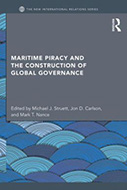Maritime Piracy and the Construction of Global Governance

Editors: Michael J. Struett, Jon D. Carlson, and Mark T. Nance
Publisher: New York, NY; London: Routledge, 2013. 226p.
Reviewer: Francis A. Galgano | May 2014
The problem of maritime piracy re-appeared in our collective consciousness in 2008 with the seizure by Somali pirates of the MV Sirius Star, a large oil super-tanker carrying $100 million in Saudi crude oil. This pirate attack was spectacular in that a small group of pirates, in a rather small boat, seized an enormous vessel far out to sea; and they demanded a $300 million ransom. This attack was followed by a number of other high-profile pirate hijackings by Somali pirates, which were punctuated by the seizure and subsequent rescue of the crew of the MV Maersk Alabama in 2009. A review of contemporary news reports indicates that most of us were astonished that piracy on the high seas was a persistent and noteworthy problem in the modern age—most of us had assumed that it had been all but stamped out as a threat. Remarkably however, maritime piracy persists globally and it is in fact growing in certain waterways of the world. Since 1992, reported cases of maritime piracy have tripled.
A review of relevant literature indicates clearly that attacks and hijackings by maritime pirates have become more frequent, violent, and costly, and increasingly jeopardize global maritime trade. For example, the disruption of global commerce can be seen in the price of gasoline at the pump. The APS Review of Oil Market Trends suggests that hijackings and alternative routes to avoid pirates engender costly delays, which can account for about 5-10 percent of the cost of a gallon of gasoline. Although a great deal of media attention has focused on Somalia, maritime piracy is a global problem; but, there have also been success stories in the suppression of piracy. For example, coordination efforts among states in South Asia appear to have helped, but elsewhere—Nigeria and Somalia for example—piracy has expanded. The problem is essentially twofold. First, most maritime piracy occurs in international waters beyond national boundaries, which are considered free to all nations and belonging to none: the so-called mare liberum principle. Second, the incidence of piracy is strongly correlated with failed or poorly governed states, which lack the ability to suppress pirate activity that emanates from their shores. Piracy and its suppression is one of universal jurisdiction and one might expect that international efforts would facilitate suppression. However, herein lies the paradox — although international law has long recognized piracy as a crime and provided tools for universal suppression, piracy still persists. This book makes a refreshing and significant contribution to understanding why the task of controlling and eliminating maritime piracy in the contemporary world is proving to be such a difficult task.
Events in Somalia during the past few years have brought maritime piracy sharply into focus. By the end of 2008, pirate attacks in the waters adjacent to Somalia became severe to the extent that the United Nations Security Council voted unanimously to authorize states to conduct military raids against pirate strongholds in Somalia. Nevertheless, the MV Sirius Star incident underscores the complex and detrimental nature of maritime piracy in the global economy. Much of the world’s trade (about 80 percent) is carried aboard some 50,000 ships. Notwithstanding the threat to the safety of merchant personnel, the direct monetary costs of piracy are consequential. Since 1997, pirate attacks have cost shipping companies approximately $200 million per year in direct losses. Added security requirements have cost shipping companies nearly $700 million for crew training and safety equipment, and an additional $1 billion for advanced communications and tracking equipment. More recently, the RAND Corporation estimates that the cost of maritime piracy is now approaching $1 billion per year.
The authors here do a remarkably effective job of illustrating that, hand-in-hand with the incidence of piracy, is the problem of governance. Even though piracy takes place on the high seas, pirates find shelter on the shores of sovereign states, and are likely to be nationals of those states. Once pirates enter sovereign territory, they are in effect immune from capture or suppression by international agencies. The problem is that in many cases governance within those sovereign boundaries is weak or non-existent. Hence, territorial jurisdiction (such as it is) trumps international or universal jurisdiction, and the suppression of a pirate node becomes difficult if not impossible. The book clearly outlines how international agencies are subject to the tyranny of geography as they try to subdue piracy in the open ocean rather than concentrate against pirate strongholds in a port, where they are most vulnerable. In the case of Somalia, a few U.S. and NATO ships patrol an area three times the size of Texas, even though we know exactly from which ports the pirate vessels emanate. The seminal issue is that there is effectively, no Somali government with which the U.S. can coordinate efforts.
There are many economic and political variables that enable maritime piracy, such as poverty, corruption, absence of a rule of law, and organized crime. However, weak or absent governance appears to be the common denominator. An examination of pirate attacks during the last decade suggests that they are highly concentrated geographically. Between 2004 and 2012, nearly 72 percent of all pirate attacks occurred in just eight places: Indonesia, the South China Sea, Nigeria, the Malacca Strait, India, Bangladesh, Tanzania, and Somalia. A review of relevant sources, such as the World Bank, United Nations reports, and the Failed States Index, indicates that these “hot-spots” are adjacent to some of the least effectively governed states in the world. Furthermore, the dynamics of economic globalization have also fostered the modern surge in crime and violence on the world’s oceans. The nexus of weakly governed places, from which pirates operate, and important shipping lanes, challenges long-standing international relations principles because these states cannot or will not exercise effective sovereignty over their territorial waters; and they provide perfect havens from which pirates can operate. This is one of the core problems addressed in Maritime Piracy and the Construction of Global Governance. The various authors examine the issue of law enforcement on the high seas and the principles of universal jurisdiction. In many cases, such as disaster relief and peacekeeping scenarios, leaders of governmental and non-governmental organizations may be able to remedy the problems presented by an un-governed space through peaceful means, using established diplomatic and international protocols. The authors point out that in such cases, well-established doctrine is reasonable as it imparts the normative guidance that is needed. However, in the case of piracy, well-established diplomatic protocols and international doctrines, and the principles they engender, must be considered in light of the legal, diplomatic, and political limbo presented by modern maritime piracy. Thus, government leaders and leaders of international agencies are now faced with the very real specter of having to employ military or security forces to subdue pirates operating within the un-governed space of a sovereign state. In this regard, Maritime Piracy and the Construction of Global Governance offers an improved theoretical understanding of the response of the international community to maritime piracy, and expands our perception of the intricate and sometimes countervailing motivations of the key actors involved.
This book also illustrates the fundamental problem of law enforcement on the high seas. The crime of maritime piracy is defined in the law of nations, but not consistently in national laws, and there is no single state or intergovernmental body that regulates maritime piracy. Furthermore, pirate attacks typically take place in international waters, which are outside of the jurisdiction of any state and usually away from regularly patrolled waters. Authority, patrolling, and enforcement is confounded because many narrow waterways and critical maritime chokepoints exploited by pirates are claimed by more than one state, and many of these same waterways are located where national boundaries are disputed, making international cooperation very difficult. Enforcement and reporting is made more complicated by the nature and dynamics of modern maritime commerce as well. Globalization and modern economic trends have essentially eliminated the existence of traditional national merchant marine fleets. Thus, maritime pirates do not threaten the hegemony of any single state; hence, attacks have not typically elicited a unilateral or multinational deterrent response. The fact is that in the contemporary world, maritime piracy may be costly to individual shippers, but at this time costs are minimal to individual states.
Maritime Piracy and the Construction of Global Governance is written by a select and impressive group of notable scholars in the field of international relations. Collectively, they employ maritime piracy as a means to examine the inconsistencies in our understanding of global governance and effective sovereignty doctrine. They employ constructivist approaches to evaluate the responses of governments and relevant international actors, and their ability to react effectively to the challenges created by maritime piracy and the modern security landscape—responses which are made more complex by non-state centric threats and violent non-state actors. In so doing, the various authors investigate a number of misconceptions associated with maritime piracy and evaluate how governments and leaders of international agencies and law enforcement organizations employ or modify long–standing international protocols in their efforts to respond to maritime pirates in the context of ungoverned international space. This book offers a refreshing view of a compelling and important segment of international law and commerce security. The authors reveal the enduring, but now perhaps irrelevant foundations of international relations theory, which have guided our collective understanding of the principles of universal jurisdiction, sovereignty, and diplomacy. They examine the fundamental principles by which we perceive governance and our response to criminal activity in international space, when it is de-linked from the territorial sovereignty of the state.
The ultimate purpose of the book is to use maritime piracy as a means to expose the incongruities in our understanding of global governance, and to provide an analysis of the legal questions linked to the prosecution and punishment of pirates, which expose questions of jurisdiction and national sovereignty. It is evident from this book that maritime piracy is a highly complex problem that demands a concerted and clearly formulated multidimensional response if the international community is to succeed in its suppression efforts. The problem of ungoverned space has complicated the dilemma and confounded our efforts, which remain linked to long-standing diplomatic norms and protocols. The authors very clearly explain why the international community has thus far been unable to come to grips with the problem of maritime piracy, notwithstanding an international consensus that it is important to eliminate this threat to commerce and security. In using a constructivist approach, the authors expose the various layers of responsibilities and confusing lines of authority that result from international security agreements, human rights law, the United Nations Convention on the Law of the Sea, the International Maritime Organization, and the freedom of the seas doctrine.
Francis A. Galgano, Department of Geography and the Environment, Villanova University


